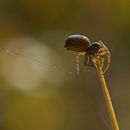Brief Summary
provided by EOL authors
Dictyna is a genus of small (3,7), web-spinning spiders that live all over the world (14).Although the delineation of this genus and its relationship to other closely-related genera are not entirely clear (16), the approximately 120 known species (13) classified in the genus Dictyna tend to have relatively wide abdomens, short legs, and a well-defined cardiac mark (the abdominal marking over the heart [17])(7).Their mouthparts, like those of other spiders in the family Dictynidae, are disproportionately long, especially in males (7,14). Dictyna spiders often build their webs on the leaves, twigs, bark, and dried flower heads of plants (4,10,11,12,18) - though they can also be found on walls and in the corners of windows(14). Most species in this genus are solitary (like the majority of spiders), but a few have a more unusual lifestyle, living in groups in a large web divided into individual units (5, 6). Like those of some other groups of spiders (15), the webs of Dictyna spiders are made in part of an old and energetically-expensive form of silk known as cribellate silk (2,5,12), each thread of which contains hundreds or even thousands of tiny fibers with dry-adhesive properties (1,2,5,15). Dictyna spiders spin these along with thicker strands of silk to form dense, zig-zagging, sometimes tent-like tangles that are especially good at catching insects (1,5,12,14,15,18). As these spiders frequently choose fruit trees (such as apple, pear, and citrus trees) (4, 10, 11) and other crop plants like cotton and alfalfa as their web-building locations, the insects they catch are often pests of these agricultural crops (10, 11). Like many other spiders (9), Dictyna spiders provide a significant service to humans by capturing and eating these insects, which include (among others) flies, leafhoppers, and aphids (10, 11). However, these spiders are also sometimes major predators of insects that are helpful in keeping invasive plant species such as spotted knapweed and yellow starthistle under control (19). Because the spread of these weeds can pose dangers to native plant life, cropland, pastures, and even horses (8, 20), these spiders can have a negative impact as well (19).
Dictyna: Brief Summary
provided by wikipedia EN
Dictyna is a genus of cribellate araneomorph spiders in the family Dictynidae, and was first described by Carl Jakob Sundevall in 1833.
- license
- cc-by-sa-3.0
- copyright
- Wikipedia authors and editors

